An online project under the direction of the CAPE ANN MUSEUM
inv. 678
The "Antelope"
Steam Demi Bark Antelope, 615 tons
1855 Oil on canvas 13 5/8 x 22 5/8 in. (34.6 x 57.5 cm)
|
Related Work in the Catalog
Explore catalog entries by keywords view all keywords »
Historical Materials
Below is historical information related to the Lane work above. To see complete information on a subject on the Historical Materials page, click on the subject name (in bold and underlined).
The steam demi-bark "Antelope" was designed jointly by Samuel Hall and Samuel H. Pook and built in Hall's shipyard at East Boston in 1855. The design concept and construction were closely overseen by Robert Bennet Forbes; the machinery was constructed by Otis Tufts and turned a Griffith propeller. Designed for traveling in pirate-infested Far Eastern waters, the vessel was heavily armed, even fitted out with a pump able to throw hot water from her boilers to a distance of 100 yards. Even the term "demi-bark" was novel, as the barkentine rig was then a novelty itself. John W. Griffiths, in describing this vessel, proposed the term "brigantern," a cross between "brigantine" and "tern," the latter term for a three-mast schooner.
This vessel was described at length by Griffiths in The U.S. Nautical Magazine and Naval Journal 3 (October 1855), 11–17, including Lane's lithograph.
– Erik Ronnberg
vol. 1, no. 1
January 1941
pp. 51-57
Also filed under: "Massachusetts" (Auxiliary Steam Packet Ship) » // Forbes, Robert Bennet »
In the ninteenth century, the term "bark" was applied to a large sailing vessel having three masts, the first two (fore and main) being square-rigged; the third (mizzen), fore-and-aft rigged. The reduced square-rig made the vessel easier and more economical to handle, using a smaller crew. (1)
Barks had significant presence in mid-nineteenth-century America, as indicated by Lane’s depictions of them. Hardly any are to be found in his scenes of major ports, but some do appear in his Cape Ann scenes (see The Fort and Ten Pound Island, Gloucester (Harbor Scene), 1848 (inv. 58), View of Gloucester, 1859 (inv. 91), Gloucester Harbor, 1850s (inv. 391), and Bark "Eastern Star" of Boston, 1853 (inv. 571)), also in views of other small ports and of coastal shipping (see Clipper Ship "Southern Cross" in Boston Harbor, 1851 (inv. 253), Merchantmen Off Boston Harbor, 1853 (inv. 267), Approaching Storm, Owl's Head, 1860 (inv. 399), and Bark "Mary" (inv. 629)).
Brigs, and to a lesser extent ships, were the vessels of choice for Gloucester’s foreign trade in the first half of the nineteenth century. They brought cargos from the West Indies, South America, and Europe, anchoring in the deeper parts of the Inner Harbor while lighters off-loaded the goods and landed them at the wharves in Harbor Cove, by then too shallow for the newer, larger merchant vessels coming into use. (2) By mid-century, barks were gradually replacing brigs and ships, while the trade with Surinam was removed to Boston in 1860. (3)
Some bulk cargos still had to be landed in Gloucester, salt for curing fish being the most important. “Salt barks” brought Tortugas salt from the West Indies, and in the 1870s, Italian salt barks began bringing Trapani salt from Sicily. The importation of salt by sailing ships ended with the outbreak of World War I. (4)
The term barkentine, like the bark, pre-dates the nineteenth century, but in the mid- to late 1800s referred to a large vessel of three masts (or more), with only the fore mast square-rigged, the others being fore-and-aft-rigged. In Lane’s time, the term was little known in the United States, while many other names were coined for the rig. One of these early terms was demi-bark, probably from the French demi-barque, which was applied to a very different kind of vessel. (5) Lane’s depictions of these rigs include a lithograph of the steam demi-bark "Antelope" View of Newburyport, (From Salisbury), 1845 (inv. 499) and at least three depictions of Cunard steamships The "Britannia" Entering Boston Harbor, 1848 (inv. 49), Cunard Steamship Entering Boston Harbor (inv. 197), and Cunard Liner "Britannia", 1842 (inv. 259). (6) None of these subjects typify the barkentine rig as applied to sails-only rigs as they developed in the years after Lane’s death.
– Erik Ronnberg (May, 2015)
References:
1. R[ichard] H[enry] Dana, Jr., The Seaman's Friend (Boston; Thomas Groom & Co., 1841. 13th ed., 1873), 97 and Plate IV with captions; and M.H. Parry, et al., Aak to Zumbra: A Dictionary of the World's Watercraft (Newport News, VA: The Mariners’ Museum, 2000), 43.
2. Alfred Mansfield Brooks, Gloucester Recollected (Gloucester, MA: Peter Smith, 1974), 56, note 10; 67, note 7.
3. James R. Pringle, History of the Town and City of Gloucester (1892. Reprint: Gloucester, MA, 1997), 106–08.
4. Raymond McFarland, A History of the New England Fisheries (Philadelphia: University of Pennsylvania, 1911), 95–96; and Mark Kurlansky, Salt: A World History (New York: Walker & Co., 2002), 419–420.
5. Parry, 44, 167. Dana has neither definition nor illustration of this rig.
6. J[ohn] W. Griffiths, “The Japan and China Propeller Antelope," U.S. Nautical Magazine III (October 1855): 11–17. This article includes an impression of Lane’s lithograph on folded tissue.
Stereograph card
Cape Ann Museum Library & Archive
This view of Gloucester's Inner Harbor shows three square-rigged vessels in the salt trade at anchor. The one at left is a (full-rigged) ship; the other two are barks. By the nature of their cargos, they were known as "salt ships" and "salt barks" respectively. Due to their draft (too deep to unload at wharfside) they were partially unloaded at anchor by "lighters" before being brought to the wharves for final unloading.
– Erik Ronnberg
Also filed under: Historic Photographs » // Salt » // Waterfront, Gloucester »
The ensign of the United States refers to the flag of the United States when used as a maritime flag to indentify nationality. As required on entering port, a vessel would fly her own ensign at the stern, but a conventional token of respect to the host country would be to fly the flag of the host country (the United States in Boston Harbor, for example) at the foremast. See The "Britannia" Entering Boston Harbor, 1848 (inv. 49) for an example of a ship doing this. The American ensign often had the stars in the canton arranged in a circle with one large star in the center; an alternative on merchant ensigns was star-shaped constellation. In times of distress a ship would fly the ensign upside down, as can be seen in Wreck of the Roma, 1846 (inv. 250).
The use of flags on vessels is different from the use of flags on land. The importance and history of the flagpole in Fresh Water Cove in Gloucester is still being studied.
The modern meaning of the flag was forged in December 1860, when Major Robert Anderson moved the U.S. garrison from Fort Moultrie to Fort Sumter in Charleston Harbor. Adam Goodheart argues this was the opening move of the American Civil War, and the flag was used throughout northern states to symbolize American nationalism and rejection of secessionism.
Before that day, the flag had served mostly as a military ensign or a convenient marking of American territory, flown from forts, embassies, and ships, and displayed on special occasions like American Independence day. But in the weeks after Major Anderson's surprising stand, it became something different. Suddenly the Stars and Stripes flew—as it does today, and especially as it did after the September 11 attacks in 2001—from houses, from storefronts, from churches; above the village greens and college quads. For the first time American flags were mass-produced rather than individually stitched and even so, manufacturers could not keep up with demand. As the long winter of 1861 turned into spring, that old flag meant something new. The abstraction of the Union cause was transfigured into a physical thing: strips of cloth that millions of people would fight for, and many thousands die for.
– Adam Goodheart, Prologue of 1861: The Civil War Awakening (2011).
Stereograph card
Cape Ann Museum Library & Archive
A view of a Cove on the western side of Gloucester Harbor, with the landing at Brookbank. Houses are seen in the woods back. A boat with two men is in the foreground.
Also filed under: Brookbank » // Fresh Water Cove » // Historic Photographs »
Courtesy American Antiquarian Society, Worcester, Mass. (CL.F9116.011.1854 CL.F9116.011.1854)
Also filed under: Oak Hall »
Courtesy American Antiquarian Society, Worcester, Mass. (CL.F9116.011.1854)
Also filed under: Oak Hall »
The use of signal flags, for ship-to-ship communication, generally preceded land-based chains of maritime semaphore stations, the latter using flags or rotating arms, until the advent of the electric or magnetic telegraph.
Until the end of the Napoleonic wars, merchant ships generally sailed in convoy as ordered by the escorting warship(s) using a few simple flags. Peace brought independent voyaging, the end of the convoy system, and the realization by various authorities that merchant vessels now needed their own separate means of signaling to each other. This resulted in a handful of rival codes, each with its individual flags and syntax. In general, they each had a section enabling ship identification and also a "vocabulary" section for transmitting selected messages. It was not until 1857 that a common Commercial Code became available for international use, only gradually replacing the earlier ones. All existed side by side for a decade or two.
Signal systems for American ships were originally intended to identify a vessel by name and owner; only later were more advanced systems developed to convey messages. Most basic were private signals, or "house flags", each of a different design or pattern, identifying the vessel's owner; identification charts were local and poorly distributed, limiting their usefulness. A secondary signal, a flag or large pennant bearing the vessel's name, was sometimes flown by larger ships, but pictorial records of them are uncommon. These private signal flags usually flew from the foremasthead or main masthead if a three master ship. Pilot boats had their own identifying flags, blue and white as seen in Spitfire Entering Boston Harbor (inv. 536). Small vessels, such as schooners, often had a "tell-tale" pennant, an often-unmarked and often red flag, that was used to determine wind direction.
A numerical code flag system, identifying vessels by the code numbers, was introduced by Captain Frederick Marryat R.N. in 1817 for English vessels. American vessels soon adopted this system. Elford's "marine telegraphic system" was the first American equivalent to the Marryat code flags, first issued in 1823, and with changes, remaining in use until the late 1850s. Most of the signal flags on vessels depicted by Lane use Elford's; Brig "Antelope" in Boston Harbor, 1863 (inv. 43) is a noteworthy example of his depiction of Marryat's. The Elford's Code was popular in America on account of its simplicity and only required six blue and white flags. Eventually these changed to red and white, although it is unclear exactly when this happened. Instructions and a key ot the Elford's Code's use are included in successive editions of the Boston Harbor Signal Book.
Whereas the other codes employ at least ten flags of diverse shapes and colours, there are only six Elford flags in total, representing the numbers one to six. All are uniformly rectangular and monochrome in colour (either blue and white or red and white—or even black and white as in an early photograph). Selected from these six flags each individual vessel is allotted a combination of four flags to be prominently displayed as a vertical hoist. Reading from above down these convey its "designated number." Armed with this number and the type of vessel (e.g. ship, bark, brig, schooner /or steamer) the subject can be uniquely identified by reference to a copy of the Boston Harbor Signal Book for the appropriate year.
– A. Sam Davidson
As reproduced in Yankee Sailing Ship Cards by Allan Forbes and Ralph M. Eastman (Boston: State Street Trust Company, 1948).
Also filed under: "Eastern Star" (Bark) » // Forbes, Robert Bennet »
Harvard Depository: Widener (NAV 578.57)
For digitized version, click here.
Also filed under: Boston Harbor »
Boston: Eastburn's Press
New York Public Library
Complete book is included in Google Books, click here.
In The American Neptune 3, no. 3 (July 1943): 205–21.
Peabody Essex Museum
Descriptions of Marryat, Elford, Rogers, and commercial code signal systems, and private signals. Includes illustrations of flag systems with color keys.
Robert Bennet Forbes (1804–89) of Boston was a key figure in his family's business in the China trade. While his brothers and cousins took positions as land-based merchants stationed either in Boston or Canton, Robert Bennet Forbes chose life at sea. He went on many trips to China, starting in 1817 as a cabin boy—thirteen years old—and eventually as a ship captain.
Forbes became a partner in the firm in 1832, known by then as Russell & Co., Canton, and went for a two-year trip to China in 1838–40 as a merchant. He was a proponent of steam power, which helped ships on the long voyage to China and Japan, and gave them the speed to evade the pirates who were ever present in the opium trade. His firm built about 70 ships, of which he was owner or part owner of several.
Robert Bennet Forbes also helped to introduce yachting as a sport, and participated in some of the first yacht races. His book Personal Reminiscences, published in 1892, lists many of these exploits, as well as all of the vessels he owned and built.
Forbes was known for his adventurous spirit. In 1846, when news of the Irish famine reached Boston, he convinced the U.S.Navy to lend him the "USS Jamestown" to take food to famine sufferers in 1847. He was the first civilian given the honor of commanding a naval vessel, and he crossed the Atlantic in a record seventeen days. Forbes wrote a book about his trans-Atlantic voyage for which he commissioned Lane to make the frontispiece illustration.
The "Jamestown" commission was one of several works Lane made for Forbes. Forbes was not only adventurous but innovative, and he commissioned Lane to make works after two of his newly designed steam vessels: the "Massachusetts," a packet ship that used steam power to supplement wind power, and the "Antelope," that relied primarily on steam power.
The Forbes family lived in Milton, Massachusetts, and also had a home in Beverly, Massachusetts. In 1856 Forbes bought land in West Manchester and built a summer home there which he christened "Masconomo" after the sagamore, chief of the Agawam.
In 1834 Captain Forbes married Rose Greene Smith. She died September 18, 1885, having borne her husband three children: Robert Bennet Forbes (1837–June 30, 1891); Edith Forbes, who married Charles Eliot Perkins; and James Murray Forbes (b. July 17, 1845). He died on November 23, 1889 in Milton.
As reproduced in Yankee Sailing Ship Cards by Allan Forbes and Ralph M. Eastman (Boston: State Street Trust Company, 1948).
Also filed under: "Eastern Star" (Bark) » // Signal Systems (Flags & Maritime Codes) »
Phillips Library, Peabody Essex Museum
1011.2 F695
Also filed under: "Massachusetts" (Auxiliary Steam Packet Ship) »
vol. 1, no. 1
January 1941
pp. 51-57
Also filed under: "Antelope" (Steam Demi-Bark) » // "Massachusetts" (Auxiliary Steam Packet Ship) »
Typed transcription of photograph caption
Manchester Historical Museum, Manchester, Mass.
Also filed under: Manchester, Mass. »
map
Manchester Historical Museum
Also filed under: Manchester, Mass. »
c. 1857
Manchester Historical Museum
In 1856 Robert Bennet Forbes bought nineteen acres of land for $2,800 from Israel F. Tappan in the section of the West Manchester shore known in those days as Newport. There he built Masconomo, named for the sagamore of the Agawam. In her unpublished letters to her son Robert, his wife Rose Greene Forbes wrote:
"...I think Father will put up a good sized cheap summer house, rough pillars, pine furniture etc., and very likely we shall all be there for two months next summer. He means to show people how rational people ought to live at the seaside. What nice times we shall have..."
The house was sold to Benjamin G. Boardman in 1865.
Also filed under: Manchester, Mass. »
Book "Family Photographs" 1:45
Privately Printed: The Riverside Press
Collection of the Forbes House Museum.
Also filed under: Forbes, John Murray » // Manchester, Mass. »
Book
University Press, John Wilson and Sons, Cambridge, Massachusetts
Second edition, 1882, contains "Rambling Recollections Connected with China." Google book version.
Also filed under: "Massachusetts" (Auxiliary Steam Packet Ship) »
Also filed under: Forbes, John Murray »
Robert Bennet Forbes scrapbook
vol. 1, p. 4
Phillips Library, Peabody Essex Museum (SCR 4)
"SPLENDID NAVAL VICTORY. We have received intelligence by the arrival of the Caledonia of one of the most splendid naval victories ever achieved under the American flag..." This article is a humorous metaphor, comparing Forbes' mission to bring food to the starving Irish to a naval assault on the city of Cork.
Also filed under: "Caledonia" (Cunard Steamship) » // "Jamestown" (U.S. Sloop of War) » // Newspaper / Journal Articles »
Perhaps painted in Canton
Collection of the Forbes House Museum
Given to the Forbes House Museum by H.A. Crosby Forbes, Ph.D., Robert P. Forbes, Ph.D., and Douglas B. Forbes in 2012
The painting was commissioned by Robert Bennet Forbes to commemorate the death of his brother, Thomas Tunno Forbes, in 1829 on "The Haide" during a storm off the coast of Macao.
Collection of the Forbes House Museum, Milton, Mass.
Scene depicts the "Jamestown" being towed out of Charlestown Navy Yard. Plaque reads: "To Captain R. Bennett [sic] Forbes / From his English friends. / The "Jamestown" American Sloop of War as she left Boston under his command / bound to CORK with DONATIONS of FOOD / freight free for the Irish. / 1847."
Also filed under: "Jamestown" (U.S. Sloop of War) »
Boston
Eastburn's Press
Link to Google Books.
Also filed under: "Jamestown" (U.S. Sloop of War) » // Lane & Scott's, Lith. – Boston » // Professional »
16 1/2 x 20 1/2 in., on sheet 18 1/8 x 22 1/2 in.
Courtesy American Antiquarian Society, Worcester, Mass.
One of these lithographs was given to R. B. Forbes at an event held on the 19th of April at the Cork Temperance Institute.
"U.S. Sloop of war, Jamestown: Capt. R. B. Forbes. This print, commemorative of the splendid generosity of the American government in dismantling a ship of war for a mission of peace and charity, & of the noble-hearted citizens who humanely & benevolently responded to the call of Irish distress, is respectfully dedicated to the President, House of Representatives, Congress and people of the United States of America, by their obedt. servants, George M. W. Atkinson, William Scraggs, Cove of Cork 13th April, 1847"
Also filed under: "Jamestown" (U.S. Sloop of War) »
Collection of the Forbes House Museum, Milton, Massachusetts
Gift to R. B. Forbes from the U.S. Navy to commemorate voyage of the "Jamestown."
Also filed under: "Jamestown" (U.S. Sloop of War) »
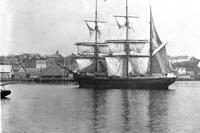

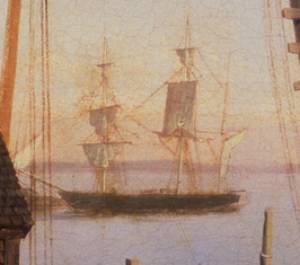


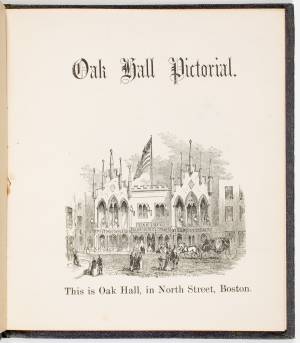
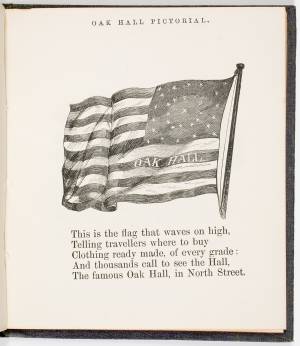






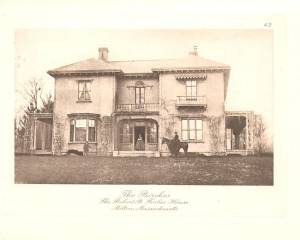
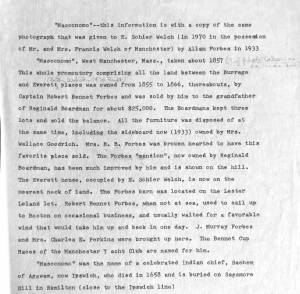
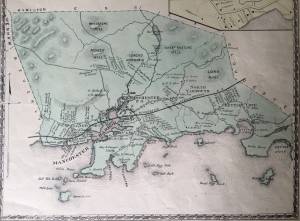
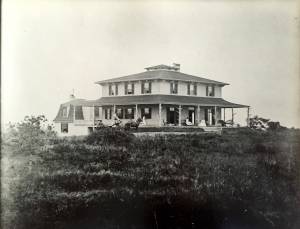
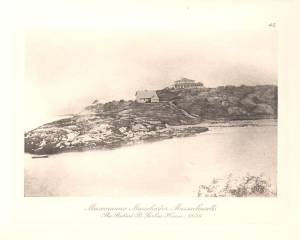
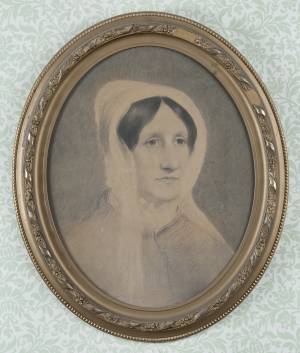


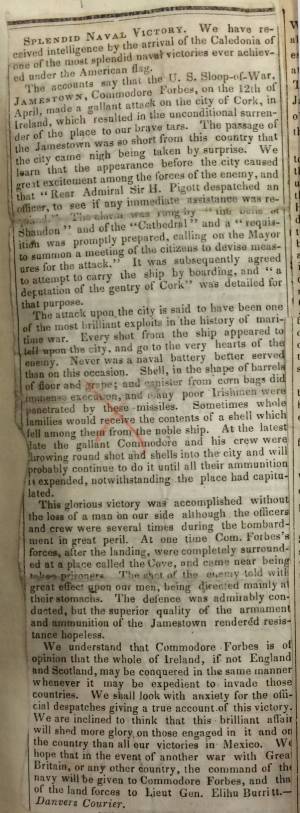
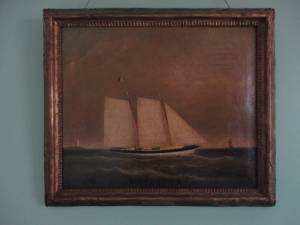
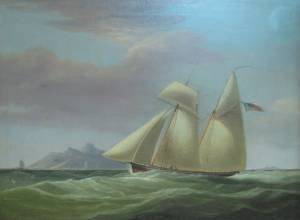

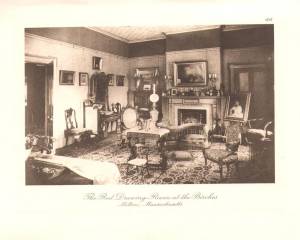


Commentary
This grisaille painting – delicately overtinted in the sea and sky with a mustard earth tone, probably raw sienna – is very likely the image on which Lane’s lithographs, Steam Demi Bark Antelope, c.1855 (inv. 413) and Steam demi bark Antelope, 615 tons, c.1855 (inv. 449) were based. Cloud formations were omitted in the prints, but the treatment of the waves and water are strikingly similar. Only an artist skilled in working in both media could give the sea in this painting a lithographic texture prior to making the lithograph itself.
“Antelope’s” barkentine rig was a novelty in her time, the terms “bark” and “demi-bark” being proposed names for it. The editor of the “U.S. Naval Magazine” even suggested the term “brigantern”, denoting the combination of the brigantine and the tern (three-masted) schooner rigs. In addition, Robert Bennett Forbes’ patent double topsail rig was a feature of the square sails on the fore mast. This vessel employed a careful compromise of sail and steam power, depending equally on both for her trans-Pacific voyages.
Designed by Samuel H. Pook in close collaboration with Forbes, “Antelope” was built in the East Boston shipyard of Samuel Hall, and was intended for the China Trade. She was heavily armed with an 8-inch shell gun and two 32-pound shell guns, all on pivot mounts. Piracy was then rampant on the China coast, requiring armaments to ensure safe passage. “Antelope” was also fitted with a steam pump which could throw hot water a distance of 100 yards to discourage boarders. Metal lifeboats with provisions for self-bailing were also carried.
“Antelope” was in the American ship registers for two years, with no record of her subsequent activity or fate.
–Erik Ronnberg
References:
1. Robert Bennett Forbes, “Personal Reminiscences,” 3rd. ed. revised (Boston, MA: Little, Brown, & Co., 1892), list of vessels (unpaginated).
2. (No author cited; probably John W. Griffiths), “The Japan and China Packet Propeller Antelope,” in “The U.S. Nautical Magazine and Naval Journal” (New York: Griffiths, Bates & Co., Vol. III, 1855-56), pp. 11–17, including a fold-out impression of Lane’s lithograph.
3. Cedric Ridgely-Nevitt, “Auxiliary Steamships and R. B. Forbes” (Salem, MA: “The American Neptune”, Vol. 1), pp. 51–57.
[+] See More